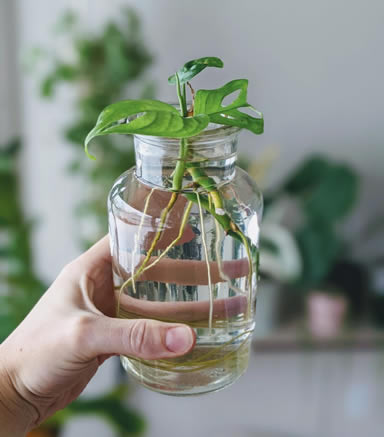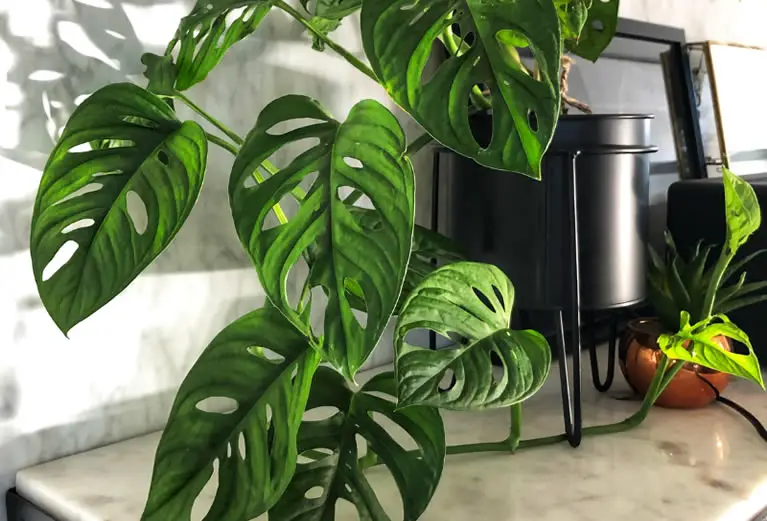Swiss Cheese Plant propagation is as fun and rewarding as the plant itself. Whether you’re trimming a leggy vine, sharing cuttings with friends, or just expanding your own jungle, Monstera adansonii roots easily and grows fast with a little care and patience.
Let’s walk through the best ways to grow new plants from this vining favorite.
Table of Contents
- Monstera adansonii
- Best Time to Propagate: Spring and Summer Are Ideal
- Stem Cuttings in Water: Quick and Satisfying
- Propagation in Pots: Go Straight to Soil
- Air Layering: For Larger, Established Vines
- Outdoor Propagation: Works in the Right Conditions
- Caring for New Plants: Gentle Light and Moisture
- Final Thoughts
Monstera adansonii
Native to the tropical rainforests of Central and South America, Monstera adansonii is a vining member of the Araceae family.

It’s known for its dramatic perforated leaves and fast, eager growth.
Unlike its cousin Monstera deliciosa, it stays more compact and is perfect for shelves, hanging baskets, or climbing poles.
Its naturally sprawling nature makes it easy to propagate—it’s as if the plant wants to multiply.
Best Time to Propagate: Spring and Summer Are Ideal
Propagate during the warmer months when the plant is actively growing.
This gives your cuttings the best chance to root quickly and settle into their new homes with minimal stress.
Stem Cuttings in Water: Quick and Satisfying
Cut a healthy vine just below a node—this is where the roots will grow.
Each cutting should include one or two leaves and one visible node.

Remove any leaves that would sit in water.
Place the cutting in a clean jar with the node submerged and set it in bright, indirect light.
Change the water every few days to keep it fresh.
Bonus Tip: Add a drop or two of a balanced liquid houseplant fertilizer—such as 10-10-10 this one, diluted to one-tenth strength—to help feed the cutting while it develops roots.
Be careful not to overdo it.
Roots should appear in 1 to 3 weeks. Once they’re a few inches long, you can transfer the cutting into soil.
Propagation in Pots: Go Straight to Soil
If you prefer to skip the water stage, you can root your cutting directly in soil.
Choose a small pot with drainage holes and fill it with a chunky, well-draining mix designed for aroids (potting soil with orchid bark and perlite works well).
Dip the cut end in rooting hormone (optional), plant it with the node just beneath the surface, and water lightly.
Cover loosely with a clear plastic bag to create a greenhouse effect, and place in bright, indirect light.
Open the bag every few days to allow air in.
New growth usually appears within 3–4 weeks.
Air Layering: For Larger, Established Vines
Choose a healthy section of stem with a node, wrap moist sphagnum moss around the node, and cover it with plastic wrap.
Keep the moss moist and wait for roots to form—this may take 3–5 weeks.
Once you see strong roots through the moss, cut just below the root ball and plant it in soil.
Outdoor Propagation: Works in the Right Conditions
If you live in USDA zones 10–12, you can propagate Monstera adansonii outdoors during the growing season.

Follow the same steps for water or soil cuttings, but keep them in a shaded, sheltered area with high humidity and warm temps.
In cooler zones, propagate indoors and move new plants outdoors only when nighttime temps stay consistently above 60°F.
Caring for New Plants: Gentle Light and Moisture
Keep young plants in bright, indirect light and lightly moist soil.
Avoid overwatering while roots are still forming, and don’t fertilize until you see new growth.
When it’s time to feed, use a diluted balanced fertilizer once a month to encourage leaf development and growth.

If climbing, support your new plant with a moss pole or trellis once it starts to stretch.
For more detailed instructions read our article Swiss Cheese Plant Care: How to Grow Monstera Adansonii Indoors and Out.
Final Thoughts
Propagating Monstera adansonii is simple, satisfying, and a great way to bring even more of this dramatic plant into your space.
Whether rooting in water, soil, or moss, you’ll find it eager to grow and easy to share.
With a little warmth, a splash of patience, and the right care, you’ll have a whole collection of Swiss Cheese beauties in no time.

